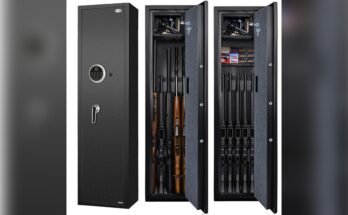You’ve invested in a biometric rifle safe to keep your firearms secure and out of the wrong hands. But have you ever stopped to wonder—can a biometric rifle safe be hacked?
If someone could bypass your safe’s fingerprint scanner or digital lock, all your precautions might be for nothing. You’ll discover the real risks behind biometric safes and what you can do to protect your valuable firearms. Keep reading to find out how safe your safe really is.

Biometric Rifle Safes Explained
Biometric rifle safes use fingerprint scanners to secure firearms. They provide quick access while keeping guns safe from unauthorized users. These safes combine technology with security to protect your weapons effectively.
Understanding how biometric locks work helps to see their strengths and limits. The technology inside these safes aims to balance safety and convenience.
How Biometric Locks Work
Biometric locks scan fingerprints to verify identity. The scanner reads ridges and patterns on your finger. It matches this data with stored profiles in the safe’s memory.
When a match happens, the lock opens instantly. It avoids the need for keys or passcodes. This quick access is crucial in emergencies.
Most systems use capacitive or optical sensors. Capacitive sensors detect electrical signals from your skin. Optical sensors use light to capture fingerprint images.
Common Features And Technologies
Many biometric safes include backup key options. This helps if the fingerprint scanner fails or battery dies. Some models offer multiple user profiles for family use.
Advanced safes have anti-tamper alarms and time delay functions. These features protect against forced entry and unauthorized access. Battery life indicators and low-power alerts are common too.
Some safes use anti-spoofing technology. This stops fake fingerprints from tricking the sensor. It raises the security level significantly.
Potential Vulnerabilities
Biometric rifle safes offer strong protection using fingerprint or face recognition. Yet, they are not completely safe. Certain weak points can let hackers bypass security. Understanding these risks helps users protect their firearms better.
Software Weaknesses
Biometric safes rely on software to process data. Bugs or coding errors can create loopholes. Hackers may exploit these flaws to unlock the safe. Outdated software increases the risk of attacks. Regular updates help fix these issues.
Hardware Exploits
Physical parts of the safe can be targeted too. Attackers may tamper with sensors or circuits. They might use tools to mimic fingerprints. Some safes have backup keys or codes that can be stolen. Proper hardware design reduces these threats.
User Errors
Users can accidentally weaken safe security. Sharing codes or leaving backup keys accessible helps hackers. Poor fingerprint registration may confuse the system. Neglecting updates also opens doors for attacks. Careful use is as important as good technology.
Real-world Hacking Cases
Biometric rifle safes offer advanced security by using fingerprint scans. Still, concerns about hacking remain. Real-world hacking cases reveal how some safes have been breached. These examples help us understand the risks and methods hackers use.
Reported Breaches
There have been a few reported breaches of biometric safes. Some attackers gained access by exploiting software flaws. Others bypassed the fingerprint scanner entirely. These incidents show no technology is fully immune to hacking.
In some cases, hackers used fake fingerprints to trick the scanner. Others found ways to reset the safe’s system without proper authorization. These breaches highlight the need for constant updates and stronger security.
Methods Used By Hackers
Hackers use various techniques to break into biometric safes. One common method is spoofing, where fake fingerprints fool the scanner. Another approach targets the safe’s software to find vulnerabilities.
Some attackers use physical tools to bypass locks or damage the scanner. Others exploit weak default passwords or unsecured Bluetooth connections. Understanding these methods helps users choose safer safes and protect their firearms better.
Security Measures To Consider
Biometric rifle safes offer convenience and security. Still, no system is perfect. Understanding security measures helps protect your safe from hacking attempts. These steps reduce risks and keep your firearms secure.
Focus on strong protection layers. Combining technology and physical barriers creates safer storage. Here are key security measures to consider.
Multi-factor Authentication
Multi-factor authentication adds extra security steps. It requires more than one way to verify your identity. For example, a fingerprint plus a PIN code. This makes it harder for hackers to break in. Even if one factor is stolen, the safe stays locked.
Firmware Updates
Firmware controls the safe’s electronics and software. Regular updates fix bugs and security gaps. Manufacturers release updates to stop new hacking methods. Installing updates keeps your safe strong against attacks. Always check for updates and apply them quickly.
Physical Safeguards
Physical safeguards protect against tampering and forced entry. Thick steel walls and strong locks make breaking in tough. Some safes have sensors that alert you to tampering. Place your safe in a hidden, secure spot. Physical strength adds a vital layer of defense.
Future Of Biometric Security
The future of biometric security holds many changes. Biometric rifle safes will become smarter and safer. Technology will grow to stop unauthorized access. Yet, new risks will also appear. Understanding these trends helps users stay secure.
Advancements In Technology
Biometric sensors are improving quickly. They read fingerprints and iris scans with more accuracy. New safes use multiple checks for better safety. Artificial intelligence helps detect fake fingerprints. Faster processors make unlocking almost instant. Battery life is extending for longer use.
Emerging Threats
As technology grows, hackers try new methods. They may use fake fingerprints or digital attacks. Some hackers target software controlling the safe. Wireless connections can be weak points. Constant updates and patches become necessary. Users must stay alert to new risks.

Frequently Asked Questions
Can A Biometric Rifle Safe Be Hacked Easily?
Biometric rifle safes use advanced encryption to protect data. While hacking is possible, it requires high skill and effort. Most safes have multiple security layers to prevent unauthorized access. Regular software updates also reduce hacking risks. Overall, hacking a biometric rifle safe is difficult but not impossible.
What Hacking Methods Threaten Biometric Rifle Safes?
Common hacking methods include brute force attacks, spoofing fingerprints, and exploiting software bugs. Some hackers use fake biometric data or override electronic controls. However, most biometric safes have anti-tamper features to detect such attempts. Manufacturers continually improve security to counter emerging threats effectively.
How Do Manufacturers Secure Biometric Rifle Safes?
Manufacturers use encryption, multi-factor authentication, and tamper alerts. They regularly update software to fix vulnerabilities. High-quality sensors detect fake fingerprints or skin patterns. Some safes lock down after multiple failed attempts. These measures make unauthorized access very challenging and enhance overall security.
Can Biometric Safes Be Hacked Remotely?
Most biometric rifle safes do not support remote access, limiting remote hacking risks. However, if connected to smart home systems, they might be vulnerable to network attacks. Users should secure their Wi-Fi and update firmware to prevent remote exploitation. Physical security remains the primary defense.
Conclusion
Biometric rifle safes offer strong protection but are not foolproof. Skilled hackers might find ways to bypass security. Still, these safes greatly reduce risks compared to traditional locks. Regular updates and good security habits help keep your safe secure. Choose trusted brands and follow safety tips for better protection.
Stay aware and cautious to protect your firearms well. Safety is always a shared responsibility between technology and the user.


